Fall in Florida may not be as colorful as in other parts of the country, but there are many autumn flowers that are blooming purple to enjoy. The more I looked around our gardens, the more purple blooms I found. So if purple is your favorite color, or if you wish to add more Florida fall color to your landscape, consider some of these pretty in purple beauties:
- Georgia Aster (Symphyotrichum georgianum) – this plant is a true show stopper when it is in full bloom in the fall, and pollinators are also highly attracted to its large purple blooms that can be up to 2″ in diameter. Its native range is small and it is a threatened species both in Florida and in Georgia due to fire suppression and development. Georgia aster is a perennial that grows 1-3′ tall, and does best in full to partial sun in well-drained soils.
- Blazing Stars (Liatris spp.) – there are 16 native Liatris species and each one blooms in beautiful purple or white wands. Blazing stars are particularly stunning when intermixed with yellow golden rod or swamp sunflowers that are also blooming this time of year. Some, like L. spicata, can get quite tall – up to 6ft – while others such as L. gracilis (https://www.fnps.org/plant/liatris-gracilis) keeps a smaller stature. Blazing stars prefer full sun and moist to dry, well-drained soils depending on the species. I very rarely see a blazing star without a butterfly friend, and when you see them in bloom you’ll understand why.
- Beautyberry (Callicarpa americana) – Beautyberry is largely ignored for most of the year, but it really puts on a show in fall. This sprawling native bush gets so heavy with dark, royal purple berries that the branches cascade down to the ground until the birds, squirrels and other wildlife have had their fill. Beautyberry is deciduous and can grow 3-8′ tall and wide in full sun to partial shade. You can sometimes find it with white berries too (https://gardeningsolutions.ifas.ufl.edu/plants/trees-and-shrubs/shrubs/beautyberry.html).
- Ironweed (Vernonia spp) – There are a few native species of ironweed, but the one most commonly found and sold is the giant ironweed (Vernonia gigantea). This tall purple beauty starts to bloom in summer and is usually done in October, but not before it puts on a lovely purple display for you and the butterflies to enjoy (https://gardeningsolutions.ifas.ufl.edu/plants/ornamentals/ironweed.html). I usually find ironweed growing in moist sites, but it can tolerate some drier soils in partial sun.
- Blue mistflower (Conoclinium coelestinum) – If you are looking for low-lying purple flowers, look no further than our native blue mistflower. Despite the name, I’d say this plant usually has lavender blooms that native bees and other pollinators can’t get enough of. But bee warned, when you have one you will likely have many more blue mistflowers popping up merrily in your fall gardens. The photo below shows blue mistflower blooming next to muhly grass (Muhlenbergia capillaris) that also adds to your purple palette.
- Mexican Bush Sage (Salvia leucantha) – Mexican Bush sage is a non-native, Florida-friendly sage that blooms beautifully in the late summer to fall and is a favorite among butterflies and hummingbirds. Many other sages, such as mealycup sage, bloom year-round until a frost, but Mexican Bush Sage waits to show off its beauty later in the year. These perennials return year after year and are excellent, low-maintenance plants to add to your landscape. They grow 1-3′ tall and wide, although the Mexican bush sage tends to have a more rounded, shrub-like appearance compared to the slender, leggier mealycup sage. Both are drought tolerant once established and do great in full to partial sun.
To find these plants, look at native plant nurseries (visit fann.org), or visit our UF/IFAS Marion County Extension Master Gardener plant sales. For future sales visit: https://sfyl.ifas.ufl.edu/marion/master-gardeners/events/
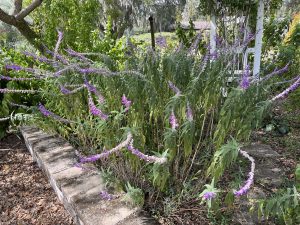

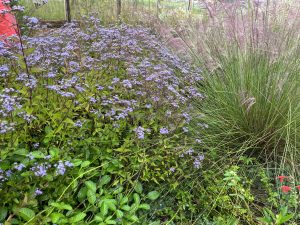
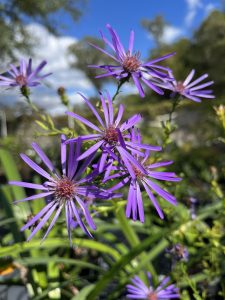
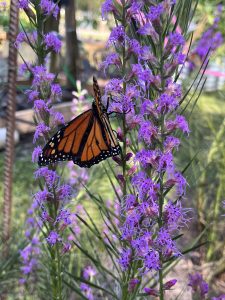
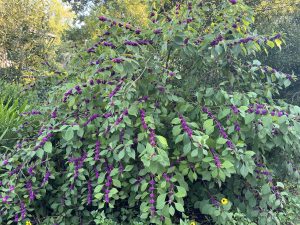
 3
3
